Undertaking a roofing project, whether it’s repairs, maintenance, or a full replacement, requires the right supplies to ensure a successful and durable outcome. As a homeowner, having a comprehensive understanding of essential Roofing Supplies Etobicoke is crucial. In this guide, we’ll explore the must-have roofing materials and tools that every homeowner should be familiar with.
1. Roofing Shingles
Roofing shingles are the primary covering for residential roofs. They come in various materials, including asphalt, wood, metal, and synthetic options. Choose shingles that suit your aesthetic preferences, climate, and budget. Asphalt shingles, known for their durability and cost-effectiveness, are a popular choice among homeowners.
2. Underlayment
Underlayment is a protective layer installed beneath the roofing shingles. It acts as a barrier against water infiltration and enhances the overall weather resistance of the roof. Common types of underlayment include asphalt-saturated felt and synthetic materials like synthetic underlayment or rubberized asphalt.
3. Roofing Nails
Roofing nails are specialized fasteners designed for securing shingles and other roofing materials to the roof deck. Galvanized or stainless steel roofing nails are preferred due to their corrosion resistance. The size and type of roofing nails depend on the roofing material being used.
4. Flashing
Flashing is a crucial component for preventing water penetration in vulnerable areas such as roof valleys, chimneys, and vents. It is typically made of metal, with options like aluminium, copper, and galvanized steel. Properly installed flashing ensures a waterproof seal and protects against leaks.
5. Roof Ventilation
Effective roof ventilation is essential for regulating temperature and preventing moisture buildup in the attic. Ventilation supplies include ridge vents, soffit vents, and attic fans. Proper ventilation extends the lifespan of the roof and contributes to energy efficiency.
6. Drip Edge
Drip edge is an L-shaped metal strip installed along the edges of the roof to direct water away from the fascia and prevent water damage. It is available in materials like aluminium and galvanized steel. Properly installed drip edge enhances the longevity of the roof by protecting vulnerable areas.

7. Roof Sealant
Roof sealant is a versatile adhesive used for sealing gaps, cracks, and joints in the roofing system. It provides an extra layer of protection against water infiltration. Siliconized acrylic or polyurethane-based sealants are commonly used for various roofing applications.
8. Roofing Adhesives
Roofing adhesives play a crucial role in securing certain roofing materials, such as underlayment and insulation boards. These adhesives are designed to withstand the elements and provide a strong bond. Common types include asphalt-based adhesives and solvent-based adhesives.
9. Roofing Insulation
Roofing insulation is essential for maintaining energy efficiency in the home. It helps regulate indoor temperatures and reduces heating and cooling costs. Common types of insulation include fibreglass, foam board, and reflective foil insulation.
10. Safety Gear
Safety should be a top priority during any roofing project. Essential safety gear includes a sturdy ladder, harnesses, safety glasses, gloves, and proper footwear. Roofers should prioritize their safety and the safety of those involved in the project.
11. Roofing Tools
A variety of tools are necessary for a roofing project. Some essential roofing tools include a roofing hammer, utility knife, chalk line, roofing nail gun, and a roofing square. These tools facilitate precision and efficiency during installation and repairs.
12. Gutters and Downspouts
Gutters and Etobicoke Eavestroughs are essential for directing rainwater away from the roof and foundation. Proper drainage is crucial for preventing water damage and maintaining the integrity of the roofing system. Choose materials like aluminium or vinyl for durability and low maintenance.
13. Ice and Water Shield
Ice and water shields are self-adhering membranes designed to offer an additional layer of protection in regions susceptible to ice dams and heavy rainfall. Applied strategically to vulnerable areas like eaves, valleys, and flashpoints, these shields create a waterproof barrier that prevents water infiltration. By acting as a resilient shield against the elements, they contribute significantly to the overall durability of a roof structure. This proactive installation is particularly beneficial in climates where ice dams are common, providing an effective defence mechanism against potential water damage and enhancing the resilience of the roofing system.
14. Roof Rake
In regions prone to heavy snowfall, a roof rake serves as a valuable tool for safely removing snow from the roof’s surface. This proactive measure aids in preventing the formation of ice dams, a common issue in snowy climates, which can lead to water damage. By regularly using a roof rake to clear accumulated snow, property owners mitigate the risk of structural damage caused by excess weight, enhance the roof’s longevity, and minimize the potential for leaks or other issues associated with ice dams. It’s a practical and preventative approach to safeguarding your property during winter months.
15. Trash Bags and Disposal Bins
Efficient disposal of old roofing materials and debris is crucial during and after a roofing project. Ensure you have an ample supply of heavy-duty trash bags and consider renting a disposal bin for streamlined cleanup. This proactive approach not only maintains a tidy and organized work environment but also contributes to the overall safety of the project. Proper waste management ensures that discarded materials are handled responsibly, minimizing environmental impact. Renting a disposal bin facilitates the convenient removal of large quantities of debris, promoting a more efficient and thorough cleanup process for a successful roofing project.
Conclusion
Having a solid understanding of essential roofing supplies empowers homeowners to make informed decisions and ensures the success of their roofing projects. Whether it’s selecting the right shingles, securing quality fasteners, or investing in safety gear, being well-equipped is key to achieving a durable and long-lasting roofing system. Remember to prioritize safety, quality materials, and proper installation techniques for a successful roofing project.




